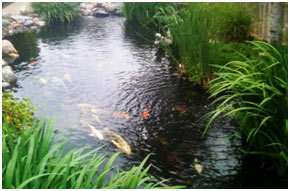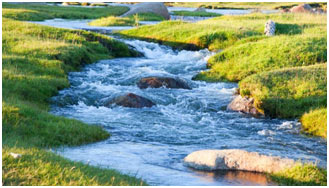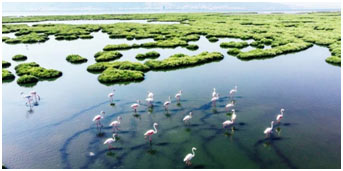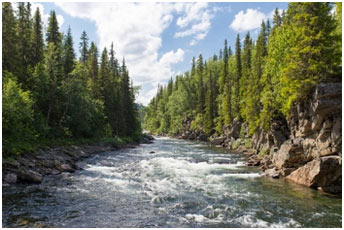Overview
The freshwater habitats cover a very small portion of the earth’s surface compared with marine and terrestrial habitats but their significance is far greater than their area.
- For humans, they are the most convenient and cheapest source of water for domestic, agricultural, and industrial needs. Freshwater components are ‘bottle-neck’ in the water cycle.
- The study of various aspects of freshwater ecosystems such as their physical or chemical composition, biological characteristics, and organisms living in them is called Limnology.
- Freshwaters are generally categorized into lentic/ still water and lotic or running or flowing water. The lentic includes ponds, swamps, marshes, etc. The logic follows a gradient from springs to mountains then streams and rivers.
- 1) Freshwater and Freshwater Ecosystem
- 2) Ponds and lakes
- 3) Streams and rivers
- 4) Wetlands
- 5) Plant life in Freshwater Ecosystem
- 6) Animal life in Freshwater Ecosystem
- 7) Some Famous Freshwater Ecosystems
- 8) MCQs on Freshwater Ecosystem
- 9) Frequently Asked Questions (FAQs)
- 10) Summary – Freshwater Ecosystem Tutorial
- 11) You may also like to learn:
Freshwater and Freshwater Ecosystem
Freshwater is specified as having a low salt concentration– typically less than 1%. Freshwater describes the water found in lakes, ponds, streams, and any other body of water other than the sea. It supports a series of plant and animal communities whose structure is formed by the availability of food, oxygen (O), temperature level, and sunlight. Freshwater ecosystems include lakes, ponds, rivers, and streams.
Ponds and lakes
These regions range in size from just a few square meters to thousands of square kilometers. Scattered throughout the earth, several are remnants from the Pleistocene glaciation. Lots of ponds are seasonal, lasting simply a number of months (such as sessile pools) while lakes may exist for centuries or more.
Ponds and lakes may have limited species variety considering that they are frequently separated from one another and from other water sources like rivers and oceans.

Streams and rivers
These are bodies of flowing water moving in one direction. Streams and rivers can be found all over– they get their starts at headwaters, which may be springs, snowmelt, and even lakes, and after that take a trip all the way to their mouths, typically another water channel or the ocean. The attributes of a river or stream changes throughout the journey from the source to the mouth.
The temperature is cooler at the source than it is at the mouth. The water is also clearer, has higher oxygen levels, and freshwater fish such as trout and heterotrophs can be found there. Towards the middle part of the stream/river, the width increases, as does species variety– various water green plants and algae can be found.
Towards the mouth of the river/stream, the water ends up being murky from all the sediments that it has gotten upstream, reducing the quantity of light that can penetrate through the water. Given that there is less light, there is less variety of plants, and because of the lower oxygen levels, fish that need less oxygen, such as catfish and carp, can be present.

Wetlands
Wetlands are areas of standing or stagnant water that support marine plants. Marshes, swamps, and bogs are all considered wetlands. Plant species adapted to the really damp and humid conditions are called hydrophytes. These consist of pond lilies, cattails, sedges, tamarack, and black spruce. Marsh plants likewise consist of such species as cypress and gum. Wetlands have the highest species variety of all ecosystems.

Plant life in Freshwater Ecosystem
Plants and algae are essential to freshwater biomes due to the fact that they offer oxygen through photosynthesis and food for animals in this biome. Cattails and reeds grow along the shoreline of numerous freshwater ecosystems. In fast-moving streams and rivers, many plants have special structures that keep them from being carried away by the water.
Some aquatic plants have strong roots that keep them anchored securely, while others have stems that bend quickly with the movement of the water. Specific mosses are able to hold on to rocks.
Animal life in Freshwater Ecosystem
Lots of animals reside in freshwater ecosystems. Some need the movement of the stream or river water to make it through. In fast-moving waters, animals that have to hold onto rocks and the bottom might have suction-cup like structures on their bodies. Others grow in still water environments, like lakes. There is a range of fish, birds, insects, amphibians, and shellfishes that make freshwater biomes their home. Trout live in both streams and rivers.
Some Famous Freshwater Ecosystems
The biggest freshwater habitat on the planet is the Everglades, a 1.5 million-acre wetlands in southern Florida. The Amazon River in South America starts in the Andes Mountains and goes 4,000 miles (6,400 km) to the Atlantic Ocean; it flows through 6 countries, consisting of Peru and Ecuador.
Lake Baikal in Siberia, an area in Russia, is the world’s greatest lake. This North Asian body of water consists of one-fifth of all the fresh water in the world.
MCQs on Freshwater Ecosystem
- 1. What is Limnology?
- A. Study of marine ecosystems
- B. Study of freshwater ecosystems
- C. Study of grassland ecosystems
- D. Study of desert ecosystems
- Answer: B
- 2. Freshwater ecosystems are essential for which human needs?
- A. Energy production
- B. Industrial needs
- C. Agricultural needs
- D. All of the above
- Answer: D
- 3. What is the salinity range defining freshwater?
- A. Less than 5%
- B. Less than 3%
- C. Less than 1%
- D. Less than 0.5%
- Answer: C
- 4. Which branch of science studies freshwater ecosystems?
- A. Oceanography
- B. Ecology
- C. Limnology
- D. Meteorology
- Answer: C
- 5. What characterizes lentic water bodies in freshwater ecosystems?
- A. Constant flow
- B. Still or standing water
- C. Seasonal variations
- D. Rapid flow
- Answer: B
- 6. What is a characteristic feature of ponds and lakes?
- A. Limited species variety
- B. High salt concentration
- C. Frequent connection with rivers
- D. Shallow depth
- Answer: A
- 7. Where do streams and rivers get their starts?
- A. Oceans
- B. Headwaters
- C. Lakes
- D. Wetlands
- Answer: B
- 8. What is true about water characteristics in the middle part of a river/stream?
- A. Clear water with low oxygen
- B. Cooler temperature with higher oxygen
- C. Murky water with high oxygen
- D. Shallow water with abundant light
- Answer: B
- 9. What is a wetland?
- A. Dry, arid area
- B. Area with standing water
- C. Mountainous region
- D. Sandy desert
- Answer: B
- 10. What is the highest species diversity among ecosystems?
- A. Deserts
- B. Rainforests
- C. Grasslands
- D. Wetlands
- Answer: D
- 11. Which organisms provide oxygen through photosynthesis in freshwater biomes?
- A. Fish
- B. Amphibians
- C. Algae and plants
- D. Birds
- Answer: C
- 12. What is an adaptation of plants in fast-moving streams and rivers?
- A. Strong roots
- B. Bending stems
- C. Suction-cup structures
- D. No roots
- Answer: B
- 13. Where is the Everglades located, the largest freshwater habitat?
- A. Southern Africa
- B. Southern Florida
- C. South Asia
- D. Southern Australia
- Answer: B
- 14. The Amazon River flows through how many countries?
- A. 4
- B. 6
- C. 8
- D. 10
- Answer: B
- 15. Which is the world’s greatest lake in terms of freshwater volume?
- A. Lake Superior
- B. Lake Baikal
- C. Great Bear Lake
- D. Caspian Sea
- Answer: B
- 16. What is the primary significance of freshwater ecosystems for humans?
- A. Aesthetic value
- B. Recreational purposes
- C. Source of water for various needs
- D. Wildlife conservation
- Answer: C
- 17. What is the primary focus of Limnology?
- A. Study of oceans
- B. Study of atmospheric conditions
- C. Study of freshwater ecosystems
- D. Study of soil composition
- Answer: C
- 18. What is the primary characteristic of lotic water in freshwater ecosystems?
- A. Still water bodies
- B. Seasonal variations
- C. Flowing or running water
- D. High salt concentration
- Answer: C
- 19. What is the primary characteristic of wetland plant species?
- A. Xerophytes
- B. Mesophytes
- C. Hydrophytes
- D. Halophytes
- Answer: C
- 20. What is the temperature trend from the source to the mouth in a river/stream?
- A. Warmer at the source
- B. Cooler at the source
- C. Constant temperature
- D. Temperature has no variation
- Answer: B
- 21. Which freshwater biome supports a variety of fish, birds, insects, amphibians, and shellfish?
- A. Deserts
- B. Rainforests
- C. Wetlands
- D. Ponds and lakes
- Answer: D
Frequently Asked Questions (FAQs)
1. What percentage of the Earth’s surface do freshwater habitats cover?
- Freshwater habitats cover a very small portion of the Earth’s surface compared to marine and terrestrial habitats.
2. Why are freshwater ecosystems significant for humans?
- Freshwater ecosystems are the most convenient and cheapest source of water for domestic, agricultural, and industrial needs, making them essential components in the water cycle.
3. What is Limnology, and what does it study?
- Limnology is the study of various aspects of freshwater ecosystems, including their physical or chemical composition, biological characteristics, and organisms living in them.
4. How are freshwater ecosystems categorized?
- Freshwaters are generally categorized into lentic (still water) and lotic (running or flowing water). Lentic includes ponds, swamps, and marshes, while lotic follows a gradient from springs to mountains, then streams and rivers.
5. What defines freshwater, and what is its salt concentration typically?
- Freshwater is specified as having a low salt concentration, typically less than 1%.
6. Why may ponds and lakes have limited species variety?
- Ponds and lakes may have limited species variety because they are often separated from one another and from other water sources like rivers and oceans.
7. How do characteristics of streams and rivers change from source to mouth?
- Characteristics change from cooler, clearer, and higher oxygen levels at the source to murkier water with lower oxygen levels towards the mouth, influenced by sediments.
8. What are wetlands, and why do they have the highest species variety?
- Wetlands are areas of standing or stagnant water supporting marine plants. They have the highest species variety due to their diverse and humid conditions, housing hydrophytes.
9. Why are plants and algae essential in freshwater biomes?
- Plants and algae provide oxygen through photosynthesis and serve as a food source for animals in freshwater biomes.
10. What adaptations do plants in fast-moving streams have?
- Plants in fast-moving streams have structures such as strong roots or bending stems to resist being carried away by water.
11. What types of animals inhabit freshwater ecosystems?
- A variety of fish, birds, insects, amphibians, and shellfishes inhabit freshwater ecosystems, adapting to different water flow conditions.
12. Name some famous freshwater ecosystems and their characteristics.
- Examples include the Everglades in southern Florida, the Amazon River flowing through six countries, and Lake Baikal in Siberia, which contains one-fifth of the world’s fresh water.
Summary – Freshwater Ecosystem Tutorial
The tutorial provides a comprehensive exploration of freshwater ecosystems, emphasizing their global significance despite covering a relatively small portion of the Earth’s surface compared to other habitats. Freshwater habitats play a crucial role in meeting human needs for domestic, agricultural, and industrial water, acting as essential components in the water cycle.
Key Points:
- Overview:
- Freshwater habitats, while occupying a small surface area, are vital for various ecological and human-related functions.
- Freshwater and Freshwater Ecosystem:
- Defined by a low salt concentration, freshwater encompasses lakes, ponds, streams, and other bodies of water excluding the sea. Limnology studies various aspects, including physical, chemical, and biological characteristics.
- Ponds and Lakes:
- Ranging in size, ponds and lakes can be seasonal or long-lasting remnants from the Pleistocene glaciation. Separation often limits species variety.
- Streams and Rivers:
- The journey from source to mouth involves changes in temperature, water clarity, and oxygen levels, influencing the variety of species, with different adaptations observed along the way.
- Wetlands:
- Wetlands, including marshes and bogs, support diverse plant life (hydrophytes) in standing or stagnant water, boasting the highest species variety among ecosystems.
- Plant Life in Freshwater Ecosystem:
- Plants and algae contribute to oxygen production and serve as food sources. Adaptations, such as strong roots or flexible stems, help them thrive in different water flow conditions.
- Animal Life in Freshwater Ecosystem:
- Diverse animal species, including fish, birds, insects, amphibians, and shellfishes, inhabit freshwater biomes. Adaptations, like suction-cup structures, enable survival in varying water environments.
- Famous Freshwater Ecosystems:
- Highlighting significant freshwater habitats worldwide, including the Everglades, the Amazon River, and Lake Baikal, each playing a unique role in the global freshwater landscape.
In conclusion, freshwater ecosystems are dynamic environments supporting rich biodiversity and serving as indispensable resources for human activities and ecological balance. Understanding their characteristics and importance is crucial for sustainable management and conservation efforts.

